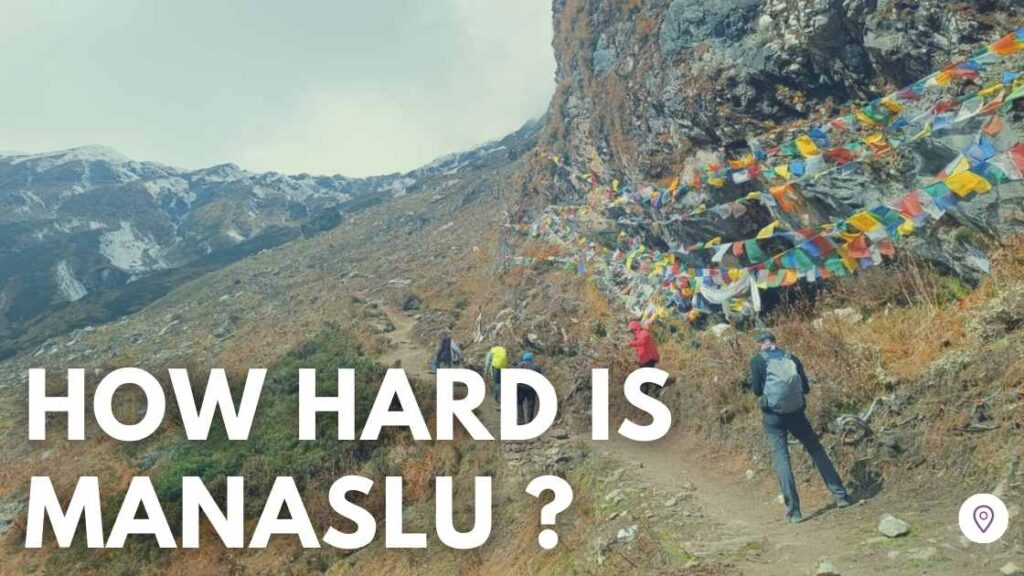So, How Hard is Manaslu? Manaslu trek is a trek of moderate difficulty that is suitable for both beginners and experienced trekkers. However, those who have never done high-altitude treks may find this trek to be a bit challenging. Manaslu trek is a less-traveled trekking route that provides breathtaking vistas of 10 peaks above 6,500 meters, with some exceeding 7000m, and occasional glimpses of the Annapurna massif. Manaslu, the eighth-highest mountain in the world, is located in the western-central part of Nepal. With a height of 8,163m, Manaslu is a well-known peak in Nepal. The region is famous for its trekking route, which follows the historic salt-trading path along the Budhi Gandaki River.
The Manaslu trek provides a trail that is less crowded compared to other popular treks, making it ideal for individuals who enjoy solitude. This adventure allows you to explore the beautiful Budi Gandaki and Nubri Valleys, surrounded by breathtaking landscapes. In the past, trekkers had to be completely self-sufficient, but now there are many tea houses available along the route, allowing trekkers to stay in local accommodations. Despite the issuance of trekking permits in 1991, this region has not received the recognition it deserves. However, there has been an increase in the number of trekkers exploring this area. How Hard is Manaslu can be determined by several factors, including the number of trekking days, weather conditions, and elevation.
Highlights:
- Spectacular vista of a mountain range encompassing Manaslu, Baudha, and Ngadi Chuli.
- Expansive forests teeming with wildflowers, rhododendrons, pines, and oaks.
- Quaint villages and lively valleys offering picturesque scenery along the journey.
- Opportunity to immerse oneself in the culture and traditions of the Himalayan natives.
- Crossing the Larkya La Pass at an elevation exceeding 5,215 meters, offering breathtaking views.
- Encountering towering cliffs, deep canyons, and awe-inspiring landscapes along the route.
Weather and Climate
During the Manaslu Trek, the weather conditions present the biggest obstacle. Trekkers will experience different weather changes during their journey. The days are typically sunny and warm, but the nights can be extremely cold in higher altitudes, with temperatures falling below freezing. Therefore, it is essential for trekkers to pack suitable warm clothing to withstand the cold temperatures.
Summer is not the ideal season for trekking to Mount Manaslu because of the excessive rainfall that makes the trekking route muddy, slippery, and infested with leeches, which can make it more challenging for trekkers. On the other hand, spring is considered the perfect season for trekking Mount Manaslu as the weather is clear, offering a clear view of the snow-covered mountains. Moreover, trekkers can enjoy the blooming of Rhododendron and the vibrant greenery, enhancing the beauty of the trek.
Trekking to Mount Manaslu is most popular during the autumn season due to the pleasant weather and stable temperature. This time offers trekkers the opportunity to witness the stunning views of the snow-covered mountains, creating an unforgettable experience. By adequately preparing and planning, trekkers can have an extraordinary and fulfilling adventure during their trek to Mount Manaslu in autumn.
Altitude Sickness
While going on the Manaslu Trek, trekkers often encounter Acute Mountain Sickness (AMS) as they ascend to higher altitudes. Although this trek presents thrilling and adventurous landscapes, acclimatizing to the elevated altitude can prove to be challenging. Manaslu Trek is a high-altitude trek that starts from 600m and reaches up to 5,106m at Larkya La Pass. Altitude sickness is a significant concern during trekking in the Manaslu region. Altitude sickness is a condition that can occur in the body when it reaches an altitude above 2500m. It is characterized by symptoms such as headache, breathlessness, and nausea. If you hurry, there is a high probability that you will be prone to altitude sickness.
When you climb to higher altitudes, the likelihood of experiencing altitude sickness increases. It is crucial to be aware of the symptoms of Acute Mountain Sickness (AMS) and the necessary precautions to reduce the risk, even if you are unaware of when your body developed the symptoms.
To ensure the best experience, it is recommended to walk at a slow pace, stay hydrated by drinking sufficient water, and refrain from consuming alcohol. It is important to avoid rushing in order to complete the trek ahead of schedule. It is important to carefully plan your itinerary and include at least one day for acclimatization in your trek. It is crucial to remember that lack of sleep and dehydration can also contribute to the development of this dangerous illness in the mountains.
Accommodation
During the peak season, hikers trekking Manaslu face significant challenges in finding suitable accommodation due to the high number of visitors attracted by the favorable weather and pleasant climate. However, even if you were able to acquire the residence, it does not meet the criteria for being considered high-end. The predominant types of lodging options found in the area are tea houses and lodges, which are mainly operated by local individuals and offer basic amenities. Tea houses offer basic amenities to trekkers, without any special treatment.
Depending on the price, they provide single or double rooms, with or without en suite facilities. During autumn and spring, there is a significant number of travelers to the region, resulting in a constant traffic jam on the route to Manaslu. If you plan to trek during these months, it is advisable to pre-book rooms as finding a place to stay overnight can be challenging. Making last-minute room reservations is not only tiring but also impossible, so it is always advisable to book in advance. Additionally, there is an additional cost for using electricity to charge devices such as phones, batteries, and cameras at all other times.
Trek Distance
The Manaslu trek covers a distance of 180 km from Kathmandu, which can be intimidating to consider. In comparison, the popular Everest Base Camp Trek only covers 130km. The trekking trail consists of various types of terrain, and walking through difficult terrain for several hours, typically 5-6 hours per day, can be a difficult task. Even experienced trekkers may find it challenging due to the rough and tough terrains.
To tackle the challenges of the Manaslu Trek, it is essential to have good physical fitness as you will be navigating through rough terrains. Additionally, you will need to be prepared to trek for several hours each day while carrying a lightweight backpack. However, you can be confident that it is possible. Prior to traveling to Nepal, ensure that you engage in regular exercise and walking for a few hours each day in your local area for several weeks. This will assist in preparing your body for the demanding trek in the Manaslu region.
What Gear Is Needed to Climb Manaslu?
- Climbing shoes.
- Camp Boots with Insulation.
- Ice axe and crampons.
- Down jacket, Gloves for mountaineering.
- Goggles.
- Harness, Carabiners, Ascenders/Descenders, Cords and fixing ropes.
- Backpack, Packs of water bottles, Headlamp, Camping equipment, such as sleeping bags may also be required depending on the adventure.
Number of Days:
This factor may seem confusing, but it is definitely one of the factors that contribute to the difficulty of the trek. You will be trekking for at least 12 days through rugged terrains and off-the-beaten-path. Only a few hikers venture into the Manaslu trail. While no special skills are needed and the path is easy, there is one exception when you reach the landslide area. The ground can be slippery in certain sections, so you need to be extra careful while walking.
The trek begins in Barpak as per the itinerary provided by Third Rock Adventures. You will trek for 12 days before returning to Kathmandu. On the 14th day, while heading towards Bhimtang through Larkya La, you will have to walk for approximately 8-9 hours. This part of the trek is known to be quite difficult and challenging due to the crossing of Larkya La. Throughout the trek, you can expect to walk for an average of 5-6 hours per day. The itinerary options for the Manaslu trek can vary. Third Rock Adventures offers a standard 17-day trek, but there are also options for a 14-day itinerary and a 12-day itinerary offered by other travel agencies.
Physical Challenges:
The Manaslu trek is a demanding experience that requires both physical and mental strength due to its steep trails, large rocks, and cliffs. The trails present challenges from the very start, with numerous ascents and descents. Those who embark on the Manaslu trek must maintain a focused mindset and remain composed throughout the entire journey. If you are planning to hike the long-distance trail of Manaslu, it is important to allocate enough time for preparation.
Building physical stamina is crucial to conquer the challenging terrain, so if you are a beginner, begin with simple yet effective physical exercises. Jogging and cycling are both excellent ways to improve endurance without putting stress on the body. Prepare yourself for a day hike, whether it’s a short or long one, but make sure to choose a route that includes a variety of terrain. Stick to a rigorous exercise routine and maintain a healthy diet to stay in good shape and prevent illness.
Food and Drinks:
Manaslu is not as popular as other hikes in Nepal because it is difficult to access and has long trails. The majority of the paths are not paved and involve steep climbs over hills, crags, and boulders. Because of the challenging environment, it is extremely difficult to transport supplies to the region, resulting in a limited variety of food items.
The most commonly available food in the area is traditional Nepali cuisine, including rice, vegetables, pulses, and pickles. Over time, the locals have become more thoughtful towards their guests by offering a variety of items, including both Western and Asian cuisines. You can indulge in delicious dishes such as stir-fried noodles, soft flatbreads, hot soup, and muesli, although they may be slightly expensive.
Frequently Asked Questions (FAQs)
1. How Hard is Manaslu to climb?
Manaslu is an intermediate to advanced level climb and is the 8th tallest peak in the world.
2. Is Manaslu Circuit difficult?
The Manaslu Circuit Trek is a trek in a remote region that brings you to the foothills of the Himalayas. The trails of this incredible journey are quite challenging, especially as you venture into unexplored and off-the-beaten landscapes along the route.
3. What is the success rate of Manaslu?
The success rate is approximately 60%. Roughly half of the climbers reach the summit without the use of supplemental oxygen. Yuko Maki, a Japanese climber, made the first ascent in the Spring of 1956.
4. Why is Manaslu so popular?
Larkya La Pass, with an elevation of 5,160 meters, is a significant factor in the popularity of the Manaslu circle trek. This pass, known as one of the most difficult sections of the trail, provides stunning views of the nearby mountains and valleys.
5. Is Manaslu a restricted area?
To protect the natural and cultural heritage of the region, the Nepalese government has imposed restrictions on trekking in the area. The Manaslu Conservation Area is a protected zone, and the government has established a set of special permits and regulations for the trek.
6. How to prepare for Manaslu?
Training for climbing includes pack-loaded uphill hiking, walking, and stair climbing for conditioning. Strength training focuses on the lower body and core. Cardiovascular training involves both aerobic and anaerobic workouts, with or without pack weight. Additionally, flexibility training is also important.

